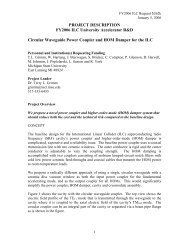Digital Hadron Calorimetry for the Linear Collider using GEM based ...
Digital Hadron Calorimetry for the Linear Collider using GEM based ...
Digital Hadron Calorimetry for the Linear Collider using GEM based ...
You also want an ePaper? Increase the reach of your titles
YUMPU automatically turns print PDFs into web optimized ePapers that Google loves.
<strong>Digital</strong> <strong>Hadron</strong> <strong>Calorimetry</strong> <strong>for</strong> <strong>the</strong> <strong>Linear</strong> <strong>Collider</strong> <strong>using</strong> <strong>GEM</strong> <strong>based</strong> Technology1. University of Texas at Arlington, 2. University of Washington, 3. ChangwonNational University, Changwon, Korea, and 4. Tsinghua University, China.Andrew Brandt 1 , Kaushik De 1 , Venkat Kaushik 1 , Jia Li 1 , Mark Sosebee 1 , AndyWhite 1 ,a, Jae Yu 1,b , Tianchi Zhao 2 , Changhie Han 3 , Li Jin 4 , Yulan Li 4 , YongfangLai 4 , Yue Qian 4a<strong>GEM</strong> detector contact: awhite@uta.edu, (817) 272-2812, (817) 272-2824 (FAX)bSimulation & Software contact: jaehoonyu@uta.edu, (817) 272-2814, (817) 272-2824 (FAX)1. Introduction. <strong>GEM</strong>-<strong>based</strong> <strong>Digital</strong> <strong>Hadron</strong> <strong>Calorimetry</strong>.We have been developing <strong>the</strong> implementation of digital hadron calorimetry <strong>for</strong> future<strong>Linear</strong> <strong>Collider</strong> detectors <strong>using</strong> Gas Electron Multiplier technology [1]. This is a criticaland essential development <strong>for</strong> future experiments that will rely on <strong>the</strong> Energy FlowAlgorithm [2] approach to achieve <strong>the</strong> required jet energy and jet-jet mass resolution. Theionization signal from charged tracks passing through <strong>the</strong> drift section of <strong>the</strong> active layeris amplified <strong>using</strong> multiple <strong>GEM</strong> foils (double or triple). The amplified charge iscollected at <strong>the</strong> anode, or readout pad, layer, which is at ground potential. This layer issubdivided into <strong>the</strong> small (~1cm x 1cm) pads needed to implement <strong>the</strong> digital approach.The potential differences, required to guide <strong>the</strong> ionization, are produced by a resistornetwork, with successive connections to <strong>the</strong> cathode, both sides of each <strong>GEM</strong> foil, and<strong>the</strong> anode layer. The pad signals are amplified, discriminated, and a digital outputproduced. The <strong>GEM</strong> design allows a high degree of flexibility with, <strong>for</strong> instance,possibilities <strong>for</strong> microstrips <strong>for</strong> precision tracking layer(s), variable pad sizes, andoptional ganging of pads <strong>for</strong> finer granularity future readout if required by costconsiderations. Fig.1 shows how <strong>the</strong> <strong>GEM</strong> approach is incorporated into a digitalcalorimeter scheme.2. Progress report on <strong>GEM</strong>/<strong>Digital</strong> <strong>Hadron</strong> <strong>Calorimetry</strong> Development2.1 Results from <strong>GEM</strong> prototypesWe have benefited from LCRD and DoE/ADR support <strong>for</strong> <strong>the</strong> past two years. Previouslywe reported initial results on signal characteristics and gain from a small prototype <strong>GEM</strong>detector. Here we give an update of results from <strong>the</strong> past year. These have been collected<strong>using</strong> <strong>the</strong> detector shown in Fig.2, <strong>using</strong> <strong>the</strong> anode pad layout shown in Fig.3.Figure 1. <strong>GEM</strong>-<strong>based</strong> digitalcalorimeter stack.Figure 2. Prototype <strong>GEM</strong>detector.Figure 3. Nine pad anode layer.
The second principal development involves production of large area <strong>GEM</strong> foils ~1m x30cm. We have been working with <strong>the</strong> Microinterconnect Systems Division of 3MCorporation, Austin, Texas to extend <strong>the</strong>ir production capability to large area foils. Atpresent <strong>the</strong>ir etching window is approximately 30cm x 30cm – to be used <strong>for</strong> our nextprototype. A modification will allow sections of 1m x 30cm to be produced. Verificationis needed of <strong>the</strong> required <strong>GEM</strong> hole alignment between <strong>the</strong> two sides of a foil to meettolerance. The processing system shown in Fig. 8 can produce up to 500 feet of foils on asingle roll.3.0 Progress Report on Simulation and Detector Per<strong>for</strong>mance Results3.1 Implementation of <strong>GEM</strong> GeometryThe UTA group has successfully implemented a double <strong>GEM</strong> layer geometry into <strong>the</strong>existing Mokka [3], a GEANT 4 [4] <strong>based</strong> simulation package, replacing <strong>the</strong> scintillationcounter sensitive layers in <strong>the</strong> TESLA TDR hadronic geometry (stainless steel/scintillation counter) with <strong>the</strong> double <strong>GEM</strong> layer structure shown in Fig.9.a. Weretained all o<strong>the</strong>r detector structure <strong>the</strong> same as in TESLA TDR detector design [5]. Inorder to optimize computer CPU resources, we have implemented a simplified version of<strong>the</strong> <strong>GEM</strong> instead of detailed geometry as shown in Fig.9.b. A comparison <strong>using</strong> single75 GeV pion events shows virtually identical energy deposit in half <strong>the</strong> CPU time <strong>for</strong> <strong>the</strong>simplified mixture version compared to a detailed geometry of a double <strong>GEM</strong> structure.Based on this study, we have decided to use <strong>the</strong> simplified geometry <strong>for</strong> fur<strong>the</strong>r studies.Figure 9. (a) Detailed double <strong>GEM</strong> geometry. (b) Simplified <strong>GEM</strong> geometry.3.2 Double <strong>GEM</strong> <strong>Digital</strong> Calorimeter Per<strong>for</strong>manceUsing <strong>the</strong> established simulation and analysis software, we have completed <strong>the</strong> study ofdouble <strong>GEM</strong> <strong>based</strong> calorimeter per<strong>for</strong>mances in analog and digital readout modes with arealistic threshold value at 98% of a MIP, <strong>using</strong> single pion samples whose energiesrange from 5 GeV to 100 GeV. The intrinsic gain of <strong>the</strong> double <strong>GEM</strong> sensitive layerswas chosen to be 3000, <strong>the</strong> value measured from our prototype, which is within 15% ofo<strong>the</strong>r measurements. The results from <strong>the</strong>se studies have been compared to TESLA TDRdetector per<strong>for</strong>mance studies <strong>based</strong> on Mokka. The resolution obtained from our studiesof TESLA TDR detector is consistent with results from o<strong>the</strong>r studies, if an energyindependentEM and <strong>Hadron</strong>ic relative normalization factor of 0.65 is used.We used <strong>the</strong> same data set generated <strong>for</strong> <strong>the</strong> analog studies of <strong>GEM</strong> calorimeter toper<strong>for</strong>m digital studies. Fig.10.a shows a profile plot of E vs N <strong>for</strong> hit-to-energy-depositconversion. Fig.10.b shows <strong>the</strong> scatter plot of energy vs number of hits, which
demonstrates <strong>the</strong> linearity of <strong>the</strong> detector in its digital readout mode. As expectedsaturation in <strong>the</strong> number of cells hit begins to appear at <strong>the</strong> higher energy deposits due tolarger energy densities in a cell. It has been observed in our study that 85% of <strong>the</strong> cellsare hit once <strong>for</strong> 5 GeV single pion showers while this fraction decreases to 74% <strong>for</strong> 100GeV single pion showers. A study of number of hit cell vs layer number <strong>for</strong> 50 GeV pionshows that it directly mimics <strong>the</strong> energy deposit distribution along <strong>the</strong> layer, providingdirect evidence and confidence that a <strong>GEM</strong> <strong>based</strong> calorimeter can be used as a digitalcalorimeter properly representing energy deposit of showers. We used <strong>the</strong> number of hitcells versus energy deposit to extract <strong>the</strong> hit-to-energy-deposit conversion factor <strong>for</strong>digital readout mode analysis.Figure 10. (a) A profile plot of energy deposit vs number of cells hit used <strong>for</strong> hit-to-energy-depositconversion. (b) A scatter plot of energy deposit . A saturation at <strong>the</strong> higher energy deposit is seen.More sophisticated procedure <strong>for</strong> fitting <strong>the</strong> responses from EM and <strong>Hadron</strong>iccomponents had to be developed to accommodate <strong>the</strong> changes in energy depositdistributions <strong>for</strong> analog and digital modes. The energy deposit measured in analog modeshows a remaining large tail due to Landau fluctuations. These large fluctuations aresuppressed in digital mode since <strong>the</strong> tail on higher energy deposit within a cell is stillcounted as one hit <strong>for</strong>cing <strong>the</strong> distribution Gaussian. Fig. 11.a and b show distributions ofenergy deposit by 50 GeV pions <strong>for</strong> analog and digital modes, respectively.Figure 12 shows <strong>the</strong> energy deposit of a 50 GeV muon in <strong>the</strong> <strong>GEM</strong> calorimeter (redFigure 11. Energy deposit of 50 GeV pions (red circles)in <strong>GEM</strong> DHCAL (a) in analog and (b) in digital modes.Figure 12. Energy deposition of a 50GeV muon(red histogram) and <strong>the</strong> cut efficiencies as afunction of discriminator threshold (dark red).
As shown in Fig. 13.b, EFA <strong>based</strong> jet energy resolution <strong>using</strong> <strong>GEM</strong> DHCAL (blue line)demonstrates <strong>the</strong> best resolution with <strong>the</strong> sampling term at around 30% which isconsistent with <strong>the</strong> expectation.3.4 Energy Flow Algorithm DevelopmentImprovement in jet energy resolution can be obtained <strong>using</strong> <strong>the</strong> energy flow algorithm.For EFA to work, one of <strong>the</strong> most important procedures is <strong>the</strong> subtraction of calorimeterenergies that correspond to charged tracks whose momenta are measured in <strong>the</strong> trackingsystem. Since any algorithm of such subtraction must work very efficiently in simplecases, we have carried out a preliminary EFA studies in two step process. First wedetermine <strong>the</strong> best algorithm to identify <strong>the</strong> centroid of a hadronic shower <strong>using</strong> singlepion events. We explored three distinct methods <strong>for</strong> centroid determination. The threemethods are: (a) Energy weighted method, (b) Simple averaging and (c) Densityweighted method. A study shows that while all three methods seem to per<strong>for</strong>m well,density weighted method seems to per<strong>for</strong>m <strong>the</strong> best <strong>for</strong> digital methods. We <strong>the</strong>n proceedto two pion shower cases in a <strong>GEM</strong> <strong>based</strong> detector in its digital mode <strong>using</strong> full detectorsimulation in Mokka through multiple iterations of matching calorimeter and trackerpositions to draw <strong>the</strong> cone of size ∆R=0.1 (half <strong>the</strong> distance between any two particles).4. Proposed Plan of work4.1 30cm x 30cm multi-channel prototypeAs <strong>the</strong> first step toward large scale <strong>GEM</strong> detector development, we will construct a stackof five double-<strong>GEM</strong> 30cm x 30cm detectors. We plan on <strong>using</strong> three of <strong>the</strong> 32-channelFermilab preamp cards, already used <strong>for</strong> our earlier prototype, as <strong>the</strong> front-end readout.We will read out a central area of 96 channels per detector, as shown in Fig.14.Figure 14. Schematic of anodelayer and front end electronics <strong>for</strong><strong>the</strong> multi-channel prototype.4.2 Discriminator and DAQ system <strong>for</strong> five double-<strong>GEM</strong> stackAs reported above, we have been <strong>using</strong> 32 channel Fermilab QPA02 ASIC card to testprototype double <strong>GEM</strong> detectors at UTA <strong>for</strong> some time. Total of 15 cards are needed toreadout <strong>the</strong> 500 channels of <strong>the</strong> cosmic ray stack and will be mounted directly on to eachlayer of <strong>the</strong> stack. Fermilab has agreed to assemble enough cards <strong>for</strong> us <strong>using</strong> <strong>the</strong> existingQPA02 chips. We expect <strong>the</strong> cost of making such cards will be small. The output signalsfrom <strong>the</strong> amplifier cards will be sent to discriminator boards which contain discriminatorchips, multiplexer stages and data output interface. The output from <strong>the</strong> discriminatorboards will be readout by a DAQ card in a PC controlled by LabView. The discriminatorboards and DAQ system will be developed at <strong>the</strong> University of Washington.4.3 Studies with five layer double-<strong>GEM</strong> stackThe stack will be used to examine <strong>the</strong> following items: single cosmic tracks hit patterns,hit multiplicity (vs. simulation), signal sharing between pads (e.g. vs. angle), efficienciesof single D<strong>GEM</strong> counters, effects of layer separators, operational experience with ~500
channel system, as a possible test-bed <strong>for</strong> ASIC when available (rebuilding one or moreD<strong>GEM</strong> chambers).4.4 Test beam module development, construction, and testingThe principal task <strong>for</strong> <strong>the</strong> next three years will be <strong>the</strong> construction and testing of a fullsize (1m 3 ) <strong>GEM</strong>-<strong>based</strong> digital hadron calorimeter stack with a total of 40 longitudinallayers. This is an essential step in <strong>the</strong> development of linear collider detector technology,in order to (a) demonstrate <strong>the</strong> viability of this technique (in parallel with <strong>the</strong> scintillatorand RPC-<strong>based</strong> approaches), and (b) make critical, energy density measurements withfine granularity (~1cm x 1cm), to tune GEANT4 as a reliable tool <strong>for</strong> EFA development.The testbeam stack will be built at UTA <strong>using</strong> <strong>the</strong> 1m x 30cm <strong>GEM</strong> foils. There will thusbe 3 double-<strong>GEM</strong> panels <strong>for</strong> each of <strong>the</strong> <strong>for</strong>ty 1m x 1m layers.The 1m 3 beam test module, if fully instrumented, requires approximately 400,000readout channels assuming 1cm ×1cm readout pads. The Fermilab-PPD electronics groupis developing a 64 channel ASIC, Fig.15, that has an adjustable amplifier gain and can beused to readout both RPCs and <strong>GEM</strong> detector planes. This ASIC will receive signalsfrom readout pads, discriminate signals, and tag hits in time to facilitate showerreconstruction. It also has a serial I/O control, serial data output line and a trigger outputas shown in <strong>the</strong> block diagram below. Each ASIC can readout a 8 x 8 detector pad array.We currently envisage that we will have 6 large multilayer printed circuit boards toreadout a 1m 2 detector plane as shown in Fig.16. Each board will host 24 ASIC chips.Figure 15. ASIC layout.Figure 16. ASIC locations on1m x 1m plane.We will start evaluating <strong>the</strong> ASIC design once <strong>the</strong> prototype chips become available(expected in late 2005). We will develop a front-end readout board design <strong>for</strong> <strong>the</strong> 30 cm x30 cm double <strong>GEM</strong> cosmic ray chambers that we will construct in FY2005. This boardrequires 16 ASICs. When <strong>the</strong> <strong>GEM</strong> foil of final size (32 cm x 96 cm) becomes availablein FY2006, we will extend <strong>the</strong> board size to 48 cm x 32 cm and design a readout system<strong>for</strong> <strong>the</strong> 1 m x 1 m plane of <strong>the</strong> 1 m 3 beam test module. It will require 6 boards to readout adetector plane as shown in bottom of figure 16. We expect that <strong>the</strong> design of <strong>the</strong>se frontendreadout boards will be somewhat different <strong>for</strong> <strong>GEM</strong> and RPC in some mechanical
aspects. The work <strong>for</strong> prototype ASIC chip testing and <strong>the</strong> front-end readout boarddevelopment will be shared between UTA and UW. We will coordinate our ef<strong>for</strong>t <strong>for</strong>developing front-end boards <strong>for</strong> <strong>GEM</strong> with <strong>the</strong> RPC group at Argonne.For <strong>the</strong> beam test module, <strong>the</strong> output signals from <strong>the</strong> front-end boards will first beprocessed by <strong>the</strong> data concentrator boards and <strong>the</strong>n sent to VME cards. These stages of<strong>the</strong> readout system will be identical <strong>for</strong> <strong>GEM</strong> and RPC. The funding <strong>for</strong> <strong>the</strong> test beamstack and associated electronics is currently <strong>the</strong> subject of a NSF-MRI proposal.4.5 Determination of Detector Parameters.A study in detector granularity <strong>for</strong> <strong>GEM</strong> detector will be conducted to determine cellsizes that can be accommodated without compromising EFA per<strong>for</strong>mance of <strong>the</strong> detector.This will also be <strong>the</strong> same <strong>for</strong> o<strong>the</strong>r parameters, such as absorber thickness, sensitive gapsize, on-board readout electronics sizes, and mechanical support structures. This will becarried out as part of <strong>the</strong> recently initiated LC detector initiatives in both <strong>the</strong> silicondetector (Si-Detector) and <strong>the</strong> Large Detector concepts.4.6 Continuation of Energy Flow Algorithm DevelopmentThe current level of EFA development is very rudimentary since <strong>the</strong> clusteringalgorithms <strong>for</strong> associating <strong>the</strong> track with <strong>the</strong> corresponding shower is simply a conedrawn around <strong>the</strong> centroid of <strong>the</strong> shower [7]. Given <strong>the</strong> erratic behavior of hadronshowers, <strong>the</strong> algorithm should be more flexible in its areas of subtraction of showerenergies. We will work closely with Argonne National Laboratory and o<strong>the</strong>r groups inEFA development. Once a reasonably per<strong>for</strong>ming algorithm has been developed, we willmove on to a multi-jet environment to test per<strong>for</strong>mance of <strong>the</strong> algorithm.4.7 Implementation of Cosmic Ray Stack GeometrySince <strong>the</strong> hardware development ef<strong>for</strong>t will move onto constructing a 30cm x 30cm fivelayer cosmic-ray stack and taking data, it is necessary to have software and simulationevolve to support this activity. In order to compare <strong>the</strong> per<strong>for</strong>mance of <strong>the</strong> cosmic-raystack with expectations from simulation, <strong>the</strong> new geometry needs to be implemented in<strong>the</strong> simulation package. In addition, cosmic-ray data analysis software must also bedeveloped. The data from <strong>the</strong> cosmic-ray stack and <strong>the</strong> simulation can <strong>the</strong>n be used <strong>for</strong>development of tracking algorithms through <strong>the</strong> calorimeter. These studies will need tobe done in both analog and digital modes to compare per<strong>for</strong>mances.4.8 Implementation of Testbeam Stack Geometry and Software DevelopmentWe expect to participate in a testbeam experiment [8] on <strong>the</strong> 2006 – 2007 time scale,contingent upon availability of funds. The geometry <strong>for</strong> testbeam experiment must beimplemented and <strong>the</strong> corresponding software <strong>for</strong> reconstruction and analysis must bedeveloped ahead of <strong>the</strong> actual data taking. Currently, Nor<strong>the</strong>rn Illinois University hasdeveloped a testbeam simulation package. We plan to exploit <strong>the</strong> existing package andimplement our <strong>GEM</strong> geometry into <strong>the</strong> system <strong>for</strong> <strong>the</strong> initial studies in <strong>the</strong> testbeamstack. Studies will also have to be conducted to determine particle types, energy rangeand statistics <strong>for</strong> adequate precision <strong>for</strong> <strong>the</strong> testbeam needs.4.9 Discharge StudyOne of <strong>the</strong> fundamental properties of <strong>the</strong> <strong>GEM</strong> detector we need to understand is <strong>the</strong>discharge probability in a given <strong>GEM</strong> gap, which might damage <strong>the</strong> <strong>GEM</strong> foil, <strong>the</strong>rebydisabling <strong>the</strong> affected area. In addition, <strong>the</strong> possibility of low energy ionization electronsspiraling through <strong>the</strong> gas gap due to <strong>the</strong> configuration of electric and magnetic fields,ca<strong>using</strong> large signals needs to be looked into to determine <strong>the</strong> method to prevent or
minimize this effect, if present. For this study, a new simulation program Garfield [9] isbeing implemented <strong>for</strong> this study since <strong>the</strong> current GEANT <strong>based</strong> simulation program weuse, Mokka, does not allow this level of detailed studies.4.10 World-wide <strong>Linear</strong> <strong>Collider</strong> Test Beam CoordinationYu has been asked to lead <strong>the</strong> American <strong>Linear</strong> <strong>Collider</strong> Test Beam working group. Hehas taken initiatives in putting toge<strong>the</strong>r a report [10] on current World-wide LC testbeamef<strong>for</strong>t and a planning document [8]. This report has been completed recently and beenreleased to <strong>the</strong> World-wide LC community. This testbeam ef<strong>for</strong>t should continue in <strong>the</strong>next 2 – 4 years to help determine technological choices and <strong>the</strong> conceptual and technicaldesign reports on both <strong>the</strong> LC detector initiatives.5.0 Timeline <strong>for</strong> proposed workFY05 - 30cm x 30cm detector stack- Develop test 1m x 30cm foils- Prototype run of ASIC and its testing- NSF- MRI start of 1m 3 test beam <strong>GEM</strong> module development and construction- <strong>GEM</strong>, SPICE, Garfield and Test Beam simulationsFY06 - Completion of 1m 3 test beam <strong>GEM</strong> module- Begin program of <strong>GEM</strong>/RPC beam tests- Fur<strong>the</strong>r EFA developmentFY07 - Fur<strong>the</strong>r beam tests, data analysis, <strong>GEM</strong>-DHCAL calorimeter system design6.0 Facilities, Equipment, and Computing ResourcesThe UTA HEP group has a 10,000 ft 2 detector construction facility, an excellentmechanical workshop, and a very high per<strong>for</strong>mance parallel computing farm. In late 2005<strong>the</strong>se facilities will be integrated as part of a new $40M Physics and Chemistry Researchbuilding.7.0 Budget and Discussion The budget request is given in <strong>the</strong> table below.Personnel We request support <strong>for</strong> a post-doctoral associate <strong>for</strong> six months, <strong>for</strong> each of<strong>the</strong> three years. The UTA postdoctoral fellow supported will be Dr. Jia Li who has beenworking on our <strong>GEM</strong> prototypes, drawer assembly techniques, and calorimeter moduledesign. We also request support <strong>for</strong> two months of engineering support in FY05 at UW<strong>for</strong> electronics design and development <strong>for</strong> <strong>the</strong> cosmic stack. We request support <strong>for</strong> agraduate student in FY06-07 to work on <strong>the</strong> testbeam stack, and analysis of data from <strong>the</strong>testbeam.ITEM FY05 FY06 FY070.5 Postdoc 21000 22050 23152.5Fringe 6300 6615 6945.75Engineer (2 months) 11500Fringe 3450Graduate student 21600 22680Fringe 9720 10206Cosmic Ray Teststand 10,000Discriminator Boards 6,000Travel 8000 8000 8000Materials and Supplies 10000 5000 5000Direct costs 76250 72985 75984.25Indirect costs 28920 35032.8 36472.44TOTAL 105170 108017.8 112456.7
Equipment We request support to construct <strong>the</strong> cosmic ray test stand to be used with <strong>the</strong>stack of five 30cm x 30cm double-<strong>GEM</strong> chambers. We also request support <strong>for</strong> <strong>the</strong>discriminator boards <strong>for</strong> <strong>the</strong> same setup to be developed at UW.Travel For each year we request a limited amount of travel support to attend <strong>Linear</strong><strong>Collider</strong> Workshops and meetings, during this development phase <strong>for</strong> <strong>the</strong> <strong>Linear</strong> <strong>Collider</strong>Detector. We also request support <strong>for</strong> one <strong>for</strong>eign trip each year to attend <strong>the</strong> LCWSconference or meeting(s) of <strong>the</strong> CALICE collaboration [11], of which UTA is a member.We have specific responsibilities that involve travel as follows: (1) Andrew White is <strong>the</strong>U.S. CALICE Steering Board representative, and (2) Jae Yu is <strong>the</strong> chairperson of <strong>the</strong>CALICE Technical Board, and <strong>the</strong> ALCPG testbeam coordinator.9.0 Broader ImpactThis project has already had an impact in a number of areas. Two graduate students haveobtained MS degrees with <strong>the</strong> studies on <strong>GEM</strong> detector per<strong>for</strong>mances and EFAdevelopment <strong>using</strong> simulated data. Currently, four undergraduate students are working onprototype development and simulations.Andrew White and a UTA condensed matter colleague have developed a highresolution Positron Emission Tomography system <strong>using</strong> <strong>GEM</strong> foils that is <strong>the</strong> subject of apatent application. We are also discussing <strong>the</strong> possible applications of <strong>GEM</strong> foils in verylarge area radiation detectors <strong>for</strong> homeland security applications.UTA has an active Quarknet educational program that has evolved into an expandingprogram of installing cosmic ray detectors in local high schools. We are currently <strong>using</strong>scintillation counters, but anticipate having students work with <strong>GEM</strong> foils once <strong>the</strong>y aremade <strong>for</strong> our project in larger quantities. The students we are working with are drawnfrom <strong>the</strong> Hispanic population of Fort Worth, Texas in an ef<strong>for</strong>t to increase <strong>the</strong> number ofsuch students pursuing careers in science.10.0 References1. F. Sauli, Nucl. Inst. Meth., A386, 531 (1997).2. ALEPH Collaboration, Nucl. Inst. Meth. A360, 481 (1995);3. Mokka Home Page, http://polype.in2p3.fr/geant4/tesla/www/mokka/mokka.html4. GEANT4, detector simulation toolkit, http://geant4.web.cern.ch/geant4/5. F. Richard, et al., TeV Energy Superconducting <strong>Linear</strong> Accelerator (TESLA)Technical Design Report, (2001); http://tesla.desy.de/new\_pages/TDR_CD/start.html6. S. Habib, “Simulation Studies of a New <strong>Digital</strong> <strong>Hadron</strong> Calorimeter, Using GasElectron Multipliers (<strong>GEM</strong>)", MS Thesis, University of Texas at Arlington, UTA-HEP/LC-003, Unpublished (2003).7. V. Kaushik, “Per<strong>for</strong>mance of Novel <strong>Digital</strong> <strong>Hadron</strong> Calorimeter Using Gas ElectronMultiplier (<strong>GEM</strong>) and <strong>the</strong> Energy Flow Algorithm Development,” MS Thesis,University of Texas at Arlington, UTA-HEP/LC-004, Unpublished (2004).8. J. C. Brient, J. Yu et al., World-wide <strong>Linear</strong> <strong>Collider</strong> Test Beam Working Group,“International <strong>Linear</strong> <strong>Collider</strong> Calorimeter Test Beam Program (A PlanningDocument <strong>for</strong> Use of Test Beam Facility at Fermilab,” FNAL-TM-2291, Inpreparation (2005).9. R. Veenhof, Simulation of gaseous detectors, http://consult.cern.ch/writeup/garfield/10. <strong>Linear</strong> <strong>Collider</strong> Test Beam Working Group, http://wwwlc.fnal.gov/lc_testbeams/wwlctb_working_group.pdf(2004)11. CALICE Collaboration, http://polywww.in2p3.fr/flc/calice.html



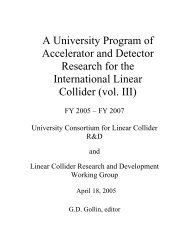
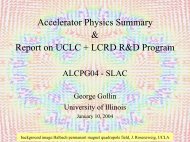
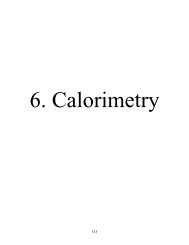

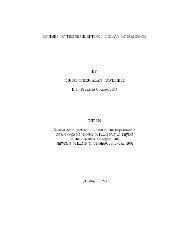

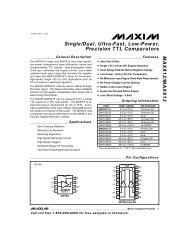



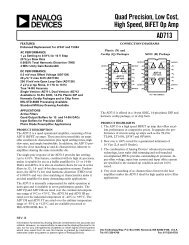

![Linear Collider [Accelerator] Overview](https://img.yumpu.com/33867705/1/190x143/linear-collider-accelerator-overview.jpg?quality=85)
